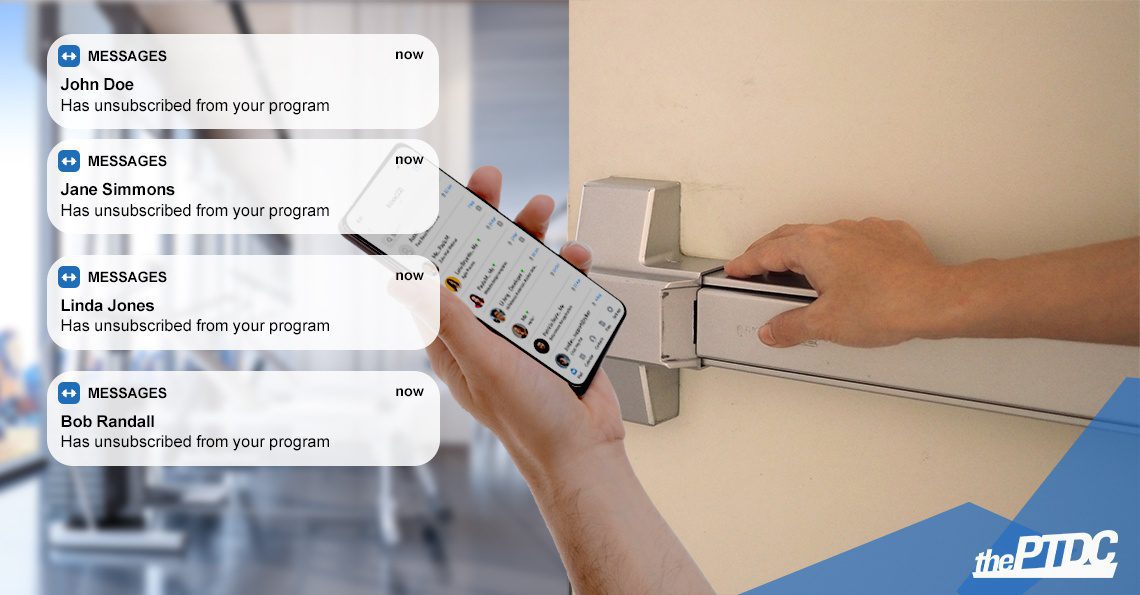I’ll never forget it.
It was a Friday—March 20, 2020—and I was sitting in the staff room with some other personal trainers at the gym in Edinburgh where we worked.
We were listening to a live broadcast from Prime Minister Boris Johnson, who had just ordered a nationwide shutdown that included gyms beginning at 10 p.m.
I had sensed something like this was coming.
When soccer leagues in the U.K. cancelled play a week earlier, I realized COVID-19 must be serious. So I’d started recording an exercise library.
I shot every variation of a squat I could think of, every version of a lunge you could do at home, every single push-up variation … I was at the gym until midnight. And then the next night I recorded 20-minute classes.
Other personal trainers were like, “What are you doing?”
I was the only one preparing.
Still ...
When gyms officially closed, it didn’t seem real.

That night I couldn’t sleep. I got up at 4 a.m. and built my whole online training system.
By the time my clients woke up wondering what they were going to do, they already had an email from me with the solution ...
I kept all but one of my original clients, and I added more at a time when most trainers were losing theirs.
In April, I saw a post about the Online Trainer Academy Level 2. This wasn’t about building a business; it was about scaling a business, which is what I needed.
I’ve since left my in-person position because I got so busy online. I earned my Level 2 certification, and also became an Online Trainer Academy Level 2 mentor, helping online coaches all over the world reach their goals.
Here are the most important things I’ve learned during these challenging times that can help you grow your online personal training business, too.
How to keep your clients and grow your successful online personal training business in 9 steps
1. Invest in the long term
Right before I joined the Online Trainer Academy Level 2, my mindset shifted from just training people online, which is what everyone else was doing, to being an online trainer.
There’s a huge difference.
One involves watching people exercise; the other involves learning marketing, sales, retention … an entire system and thought process.
One is a temporary solution; the other is a permanent solution.
So while other personal trainers were thinking maybe two months ahead and trying to save money, I saw an opportunity to invest in myself for the long-term.
If you’re afraid of losing clients when the gyms reopen …
Or if you don’t want to return to in-person training …
Ask yourself, “Have I made the decision to become an online trainer and make this permanent?” Or, “Have I decided to just watch people squat?”
Think of marathon running. For many people, it’s just a one-off thing. They buy shoes and clothing that will do, and then once they do the marathon they may never run again.
But if you decide to become a runner, you buy the best shoes, the best water bottle, the best everything, and the marathon becomes just one part of being a runner.
It’s an investment in a new lifestyle, and that’s what it takes to succeed.
(Find out what investment is right for your online personal training business.)
2. Make yourself indispensable
My advice: Think about the experience your clients are having.
If they’re reaching their goals, if you’re following through on your promises, if you have them set up in a good program … they won’t want to leave you. They will consider you indispensable.
When COVID kicked in, many trainers got dropped because they were seen as a luxury. My guys stayed with me because they saw me as a necessity.
This is a massive perception change that all personal trainers need to work on. And you do it by seeing the client as a person.
You have to understand what’s driving them. You have to care.
That was the difference for me: I saw my clients as people. I made it a point to have a 15-minute chat with each one every three to four weeks.
This was never scheduled; I would just call.
And it wasn’t to talk about exercise; it was to check in on them as humans.
How have you been sleeping?
What’s your stress level?
How is home-schooling the kids going?
Sometimes I even sent them gifts. And I’m not talking about a shirt or mug with my logo on it.
I’m talking about a personal gift that comes from you listening. Maybe a client mentioned once that she’s a huge Star Wars fan. So I sent her a Star Wars mug.
Connecting with clients on a personal level makes you a member of their support team, much like a partner or a friend, rather than a luxury.
(Need more clients? Here’s five steps for building your personal training client roster.)
3. Find the pain point and become the solution
As an in-person trainer, I never had to sell on the phone. The Online Trainer Academy Level 2 taught me how to do that.

The biggest thing I learned is you have to dig deep on a phone call and reach the person’s pain points.
A pain point is the root cause of why someone wants to lose weight or get back in shape, and they usually won’t tell you this straightaway. So a potential client might say …
“I want to lose weight.”
Well, I’m going to need a bit more. Why do you want to lose weight?
“Because I want my clothes to fit better.”
Why do you want your clothes to fit better?
“Because when I look in the mirror, I don’t like what I see.”
There you go. That’s the pain point. You don’t get that on the first question.
You get that by listening and digging and finding the real reason behind what’s triggering a deep negative feeling. In some cases, they may not have even shared it with their partner.
You can do this on the phone really well, because people aren’t expecting it. They’re expecting you to say, “Oh, I have this program that does XYZ; do you want to try it?”
Instead, you take them on this journey and then, once you understand what’s really driving them, you don’t just offer a program; you offer a solution.
And that’s irresistible. They sign up.
4. Charge for the solution, not your time
Clients expect things online to be less expensive or even free. Every in-person trainer transitioning to online worries about this.
But don’t fall into the trap of charging by the hour. Online you don’t charge people for your time; you charge them for the solution.
If a client needs a 50-minute call with you instead of 15 minutes, they get it. If someone needs more support from you, they get it.
That mindset shift changes the psychology of the entire relationship—for them and for you.
It’s what allowed me to double my monthly rate because of the perceived added value.
And as the Online Trainer Academy Level 1 taught me: People who pay, pay attention—meaning when they’re paying top price for something, they’re going to be more invested and do everything they’re told to do.
And, lo and behold, they’ll get better results.
Which ultimately makes you look good and be more successful.
Not sure what to charge? These tips will help you figure out what to charge for your personal training.
5. Never mention time frame
If you signed someone up for 12 weeks, never say, “Oh, you’re on week four” or “You have eight weeks left.”
Instead say, “You’re making such great progress, imagine where you’ll be in six months or a year!”
That’s because the minute you start talking time-frame, they’ll start seeing 12 weeks as the end point. And you don’t want them to think like that.
Instead, when week 11 rolls around, say:
“You’ve done an amazing job in the last three months. You came to me wanting X and we achieved XYZ. What else would you like to achieve in the next six months?”
Once you get them thinking like that, say:
“I’m not sure if it’s for you, but I do have a legacy program that will allow you to continue training with me so you can smash those goals. Sound good? Let’s do it!”
If they hesitate …
6. Don’t be afraid to hold your clients accountable
For example, if they say they struggle with making decisions and then hesitate when you tell them the cost, say:
“Do you mind if I hold you accountable for something you said to me earlier in the call? You told me you struggle with making decisions, and now we’re in the same position. Are there other times you can think of where this has maybe held you back from bettering yourself?”
7. Talk to your clients the way you like others to talk to you
I often get messaged by business coaches saying, “I can help you grow your business to six figures in the next 30 days.”
I find that nauseating.
If you do, too, don’t use that strategy with potential clients. Instead, ask yourself how you would like that conversation to happen.
Maybe you’d prefer for a coach to get to know you, interact in a few posts, and then reach out when you show interest.
If so, then that’s how you should interact with prospects. Because that’s what feels natural to you.
8. Celebrate all forms of success
A lot of issues personal trainers have can be solved well before they come up.
I’m talking about doing things as simple as having regular check-ins with clients; people are craving connection during the time of coronavirus.
And make sure to celebrate all kinds of success, not just weight loss or setting a new personal best.
Celebrate a mindset shift. That’s massive for them.
For someone to be able to eat a chocolate bar and not punish themselves for days afterward is a triumph. Eating normally the next day and not feeling guilty is going to have a much more significant impact on that person’s life than being able to squat an extra 10 pounds.
Look for these things, call them out, and celebrate.
9. Lead your clients
When I transitioned my clients to online training in April 2020, no one had any answers.
I hadn’t trained online before and neither had any of my clients.
I had no idea if it was going to work, but I didn’t tell them that. I showed confidence. I led them.
And that’s key. If you lead, they will follow.
If you talk in a way that shows this is the best way forward for them—here’s what we’re going to do, here’s how it benefits you, here’s when it starts—then they will do whatever you tell them.
And don’t forget the free upgrade! That’s what I did.
If they’re used to doing an hour Zoom call with you privately each week, and you’re worried how they’ll react if you take that away and go to an hour in an online group, tell them they’ll get more support because they’ll be in a community and will be able to ask you questions anytime. (Although, you answer them at a time that suits you.)
Say: “So on April 1, this is the model we are going to have, and I am going to give you a free upgrade to that.”
You lead, they’ll follow.










